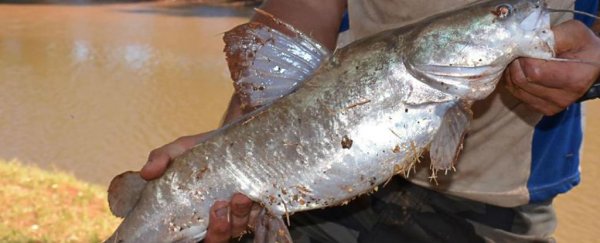Researchers have confirmed that a population of catfish in Western Australia are catching and eating live mice, but they have no idea how they're doing it.
While there have been reports of European catfish deliberately beaching themselves to snare a pigeon or two in the past, these Australian catfish appear to keep to the water, and their rodent prey appear to keep to the land. So what's going on here?
As part of a larger investigation into the health of native catfish in certain regions of Australia, a team from Murdoch University in Perth caught 18 lesser salmon catfish (Neoarius graeffei) from the Ashburton River in Western Australia - one of the largest dryland rivers in the country.
To their surprise, when they opened up the stomachs of the fish to get an idea of their diets, 44 percent of them were filled with the remains of spinifex hopping mice (Notomys alexis) - a jumpy little native species that keeps to the arid, desert areas of central and western Australia.
And we're not just talking about a single mouse here or there - some of the fish had helped themselves to a few.
"It was pretty surprising - about half had at least one in their stomach, and two of them had three," one of the team, David Morgan, told Shannon Verhagen at Australian Geographic. "Overall, 95 percent of the total stomach contents constituted spinifex hopping mice."
 Erin Kelly et. al.
Erin Kelly et. al.
Morgan explained that the thing that tipped them off about the Ashburton River catfish's strange diet was the fact that they were growing significantly larger than other populations in the northern half of Australia.
While an average lesser salmon catfish will look sleek and grow to about 50 cm long, the Ashburton River catfish can often reach 75 cm in length, and Morgan said their bloated appearance ultimately gave them away.
"It was quite obvious - some of the catfish had really distended stomachs and we were wondering what was in there," he said.
The fact that the catfish are making a meal out of some unfortunate mice isn't all that surprising, because catfish, and many other large freshwater fish, are both omnivorous and opportunistic eaters.
A number of large fish species have been caught chowing down on small rodents in the past - this voracious Alaskan rainbow trout was found with no less than 20 shrews in its belly back in 2013. "[That's] an awful lot for one fish to put down," a researcher said at the time.
And who could forget that time when researchers in Europe realised that local catfish populations had figured out how to catch pigeons on the shoreline:
The difference here is that Ashburton River catfish have not been observed leaving the water, and spinifex hopping mice have not been observed approaching it. Ever.
Instead, the researchers suspect that the underground burrows of the mice are collapsing in heavy rains, and this could send their cute, sleepy bodies into the hungry mouths of the river nearby.
"We thought perhaps we'd had localised rain and some of the mice's extensive burrows may have collapsed, sending them into the river," David told Australian Geographic, adding that they're not going to rule out the possibility that these fish have taught themselves to snare mammal prey from the river bank just yet.
It is Australia, after all. Let's just say our animals are pretty… creative when it comes to finding a meal.
The study has been published in the Journal of Arid Environments.
